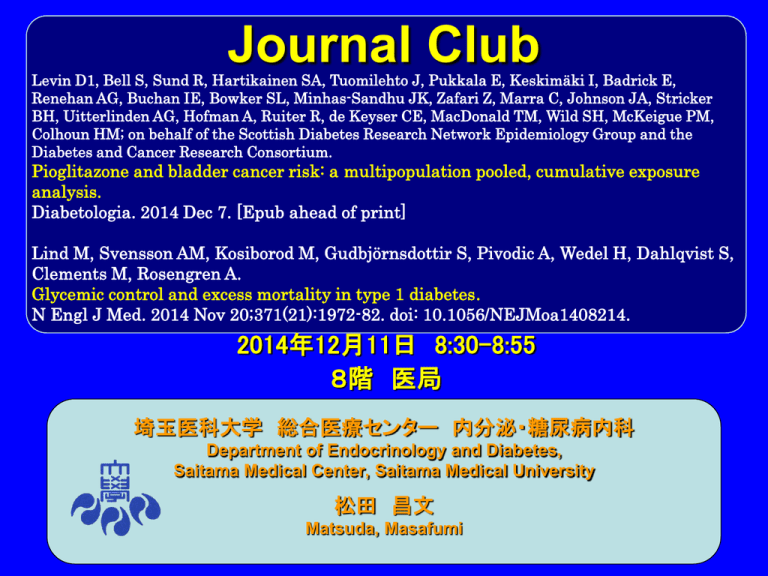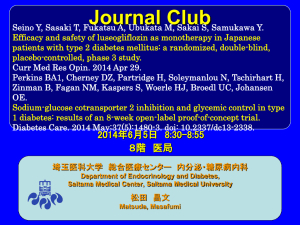
Journal Club
Levin D1, Bell S, Sund R, Hartikainen SA, Tuomilehto J, Pukkala E, Keskimäki I, Badrick E,
Renehan AG, Buchan IE, Bowker SL, Minhas-Sandhu JK, Zafari Z, Marra C, Johnson JA, Stricker
BH, Uitterlinden AG, Hofman A, Ruiter R, de Keyser CE, MacDonald TM, Wild SH, McKeigue PM,
Colhoun HM; on behalf of the Scottish Diabetes Research Network Epidemiology Group and the
Diabetes and Cancer Research Consortium.
Pioglitazone and bladder cancer risk: a multipopulation pooled, cumulative exposure
analysis.
Diabetologia. 2014 Dec 7. [Epub ahead of print]
Lind M, Svensson AM, Kosiborod M, Gudbjörnsdottir S, Pivodic A, Wedel H, Dahlqvist S,
Clements M, Rosengren A.
Glycemic control and excess mortality in type 1 diabetes.
N Engl J Med. 2014 Nov 20;371(21):1972-82. doi: 10.1056/NEJMoa1408214.
2014年12月11日 8:30-8:55
8階 医局
埼玉医科大学 総合医療センター 内分泌・糖尿病内科
Department of Endocrinology and Diabetes,
Saitama Medical Center, Saitama Medical University
松田 昌文
Matsuda, Masafumi
ピオグリタゾン
Bays H, Mandarino L, DeFronzo RA. J Clin Endocrinol Metab. 89:463-78, 2004. を日本人向けに描画
RECORD study
Lancet. 2009 Jun 20;373(9681):2125-35.
Epub 2009 Jun 6.
2011年6月24日
Diabetologia
Volume 55, Number 7 (2012), 1953-1962,
DOI: 10.1007/s00125-012-2538-9
the Department of Internal Medicine, National Taiwan University College of Medicine,
Taipei, Taiwan, and the Division of Endocrinology and Metabolism, Department of
Internal Medicine, National Taiwan University Hospital, Taipei, Taiwan.
Among 165 incident case subjects, 10 (0.39%) were ever
users and 155 (0.30%) were never users of pioglitazone
(adjusted hazard ratio in full model 1.305 [95% CI 0.661–
2.576]). All bladder cancer in ever users occurred within a
duration of therapy, 24 months, suggesting an early effect of
pioglitazone on bladder cancer or late use of pioglitazone in
high-risk patients.
Diabetes Care 35:278–280, 2012
PROactive試験における癌患者発生率
アクトス群(n=2605)
イベント例数
新生物
患者例数
プラセボ群(n=2633)
イベント例数
患者例数
p
118
112
(4%)
117
113
(4%)
NS
103
97
(4%)
103
99
(4%)
NS
結腸直腸癌
16
(1%)
15
(1%)
0.834
肺癌
15
(1%)
12
(1%)
0.544
膀胱癌
14
(1%)
6
(<1%)
0.069
膀胱癌(除外後)§
6
(<1%)
3
(<1%)
0.309
造血器癌
6
(<1%)
10
(<1%)
0.327
乳癌
3
(<1%)
11
(<1%)
0.034
47
(2%)
46
(2%)
0.876
悪性新生物‡
その他
‡:症例の中には複数種の腫瘍も認められている
§:盲検解除後に検討した例
There was no difference in the overall incidence of malignant neoplasms. There were some imbalances in the
incidence of individual tumours. There were more bladder tumours (14 vs six) and fewer cases of breast cancer
(three vs 11) reported in the pioglitazone group compared with placebo.
悪性新生物の全体的な発生率に差は認められなかった。個々の腫瘍の発生率のいくつかの不
均衡があった。プラセボと比較してピオグリタゾン群で膀胱腫瘍(14対6)が多く、乳がんは
(3対11)有意に低下していた。
Dormandy J.A. et al:Lancet ,366,1279,2005.
PROactive試験における癌患者発生率
アクトス群(n=2605)
イベント例数
膀胱癌
プラセボ群(n=2633)
患者例数
14
イベント例数
患者例数
6
(1%)
(<1%)
5
p
0.069
0.040
非盲検化される前にデータ安全性モニタリング委員会は、外部専門家(S·コーエン:ネブラスカ大学医療セ
ンター、Dフィリップス:癌研究英国の研究所)による20膀胱例を検討を実施。
20例
9例
3例
アクトス:14例
プラセボ:6例
アクトス:6例
プラセボ:3例
アクトス:2例
プラセボ:1例
ランダム化の1年以内発生
喫煙、曝露が、家族歴、以前の腫瘍、尿路感染症等
発がんリスク上昇因子あり
11例
6例
アクトス:8例
プラセボ:3例
アクトス:4例
プラセボ:2例
Dormandy J.A. et al:Lancet ,366,1279,2005.
In the overview of PROactive data published in 2009, Dormandy and colleagues anecdotally mentioned that, in
the placebo group, one case in fact showed a benign histology. (Hillaire-Buys D: Lancet 378:1543-44, 2011)
膀胱癌の発生リスク(アクトス投与歴有無での比較)
(%)
累
積
膀
胱
癌
発
症
率
3
ピオグリタゾン投与歴あり(Pio)
ピオグリタゾン投与歴なし(None)
2
二重盲検期間
カプランマイヤー法
HR 0.98(95%CI 0.55-1.77)
p=0.959
追跡観察期間
最短
最長
投与歴あり
1
投与歴なし
0
例数
Pio 2,783
None 2,455
0
2,323
1,971
1,824
1,464
1,526
1,206
1,000
2,000
3,000 (日)
ランダム化からの期間
PROactive
開始時
ピオグリタゾン
n=2,605
プラセボ
n=2,633
PROactive終了後
追跡開始時
ピオグリタゾン
n=1,820
プラセボ
n=1,779
追跡観察6年
非 TZD
n=1,449
ピオグリタゾン
n=246
他 TZD
n=144
非 TZD
n=1,497
ピオグリタゾン
n=179
他 TZD
n=127
プラセボ群に割り付けられた患者のうち試験終了後にピオグリタゾンが投与された179名は投与歴ありとして解析した。
Spanheimer R.;ADA 72th Scientific Sessions,2012, Philadelphia.
Pioglitazoneと膀胱癌発現リスクに関する主な研究報告(1)
調査名又は
掲載雑誌名
アクトス投与による膀胱癌発症リスク
ハザード比(95%信頼区間)
引用された
データベース
1.2(0.9‐1.5)
カルフォルニア州
の医療保険
データベース
CNAMTS2)
1.22(1.05‐1.43)
フランス医療保険
データベース
(SNIIRAM)
Hepatology3)
0.95(0.70‐1.29)
KPNC1)
1.305(0.661‐2.576)
Diabetes Care4)
1.83(1.10‐3.05)
BMJ5)
Br J Clin Pharmcol6)
台湾国民健康
保険登録
データベース
主解析
1.16(0.83‐1.62)
プロペンシティ・
スコアを用いた解析
1.22(0.80‐1.84)
1)Lewis JD et al.; Diabetes Care ,34,916,2011.
2)Neumann A.;Diabetologia,55,1953,2012
3)Chang C.H. et al;Hepatology. 2011 Dec 2.
英国医療保険
データベース
(GPRD)
4)Tseng C.H.et.al.; Diabetes Care,35,2,278,2012
5)Azoulay L.et.al.;BMJ,2012
6)Li Wei et al;Br Clin Pharmacol,2012
Pioglitazoneと膀胱癌発現リスクに関する主な研究報告(2)
調査名又は
掲載雑誌名
JNCI1)
Diabetes Metab J2)
膀胱癌発現リスク
SU薬使用例(41,396
例)に対するチアゾリ
ジン薬使用例(18,459
例)のハザード比
ケース・コントロール
試験における
膀胱癌症例(329例)
と非膀胱癌症例(658
例)のピオグリタゾン
の使用率比較
多変量解析における
ピオグリタゾン使用歴
のオッズ比
0.93
(95%CI: 0.68-1.29)
膀胱癌症例 6.4%
非膀胱癌症例 15.0%
(p<0.001)
引用された
データベース
英国実地診療
データベース
(THIN)
韓国Yonsei大学
Severance病院
データベース
2.09
(95%CI: 0.260-16.814)
1)Mamtani R.et al.;JNCI, 104,18,1411,2012
2)Song S Ok.;Diabetes Metab J,36,371,2012
KPNC研究:ピオグリタゾンと膀胱癌発現リスク
(5年間と8年間の中間解析結果比較)
5年間
ピオグリタゾン使用
総補正後HR*
(95%CI)
1.17(0.92-1.49)
ピオグリタゾン使用開始からの期間
8年間
総補正後HR*
(95%CI)
1.07(0.87-1.30)
減っている!
1.5年未満
1.17(0.79-1.74)
3.5年未満
0.96(0.74-1.24)
1.5-3年
1.37(0.91-2.06)
3.5-6.5年
1.07(0.77-1.48)
3年超
1.27(0.89-1.82)
6.5年超
1.19(0.78-1.80)
1年未満
0.83(0.55-1.26)
1.5年未満
0.78(0.57-1.05)
1-2年
1.40(0.92-2.13)
1.5-4年
1.15(0.87-1.53)
2年超
1.44(1.03-2.02)
4年超
1.62(0.96-2.74)
4年超
1.30(0.91-1.86)
p=0.03
Test for trend
p=0.24
1-10,500mg
1.02(0.71-1.47)
1-13,000mg
0.89(0.67-1.20)
10,501-28,000mg
1.18(0.80-1.75)
13,001-35,000mg
0.98(0.71-1.35)
>28,000mg
1.43(0.96-2.12)
>35,000mg
1.25(0.91-1.74)
ピオグリタゾンによる累積治療期間
Test for trend
累積投与量
*補正項目: 年齢、性、人種、他の糖尿病治療薬、喫煙、他の膀胱の状況、収入、心不全、他の癌、腎機能不全、
HbA1c、糖尿病罹病期間。 8年間解析では、KPNC研究登録後の期間も含む。
Lewis JD et.al.: http://clinicaltrials.gov/ct2/show/NCT01637935?term=KPNC&rank=1
D. Levin : H. M. Colhoun Diabetes Epidemiology Group, Population Health Sciences, University of Dundee, Dundee, UK; S. Bell (*) Renal Unit, Ninewells
Hospital & Medical School, Dundee DD1 9SY, UK e-mail: samira.bell@nhs.net; R. Sund Centre for Research Methods, Department of Social Research,
University of Helsinki, Helsinki, Finland; J. Tuomilehto Hjelt Institute, Department of Public Health, University of Helsinki, Helsinki, Finland; S. A. Hartikainen
School of Pharmacy, University of Eastern Finland, Kuopio, Finland; J. Tuomilehto Department of Chronic Disease Prevention, National Institute for Health and
Welfare, Helsinki, Finland; J. Tuomilehto Center for Vascular Prevention, Danube University Krems, Krems, Austria; J. Tuomilehto Diabetes Research Group,
King Abdulaziz University, Jeddah, Saudi Arabia; E. Pukkala Institute for Statistical and Epidemiological Cancer Research, Finnish Cancer Registry, Helsinki,
Finland; I. Keskimäki Division of Health and Social Services, National Institute for Health and Welfare, Helsinki, Finland; E. Pukkala : I. Keskimäki School of
Health Sciences, University of Tampere, Tampere, Finland; E. Badrick Institute of Population Health, University of Manchester, Manchester, UK; A. G.
Renehan Faculty Institute of Cancer Sciences, University of Manchester, Manchester, UK; I. E. Buchan Farr Institute @ HeRC, University of Manchester,
Manchester, UK; S. L. Bowker : J. K. Minhas-Sandhu : J. A. Johnson School of Public Health, University of Alberta, Edmonton, AB, Canada; Z. Zafari Center
for Clinical Epidemiology and Evaluation, Vancouver Coastal Health Institute, Vancouver, BC, Canada; C. Marra Faculty of Pharmaceutical Sciences,
University of British Colombia, Vancouver, BC, Canada; B. H. Stricker : A. G. Uitterlinden : A. Hofman : C. E. de Keyser Department of Epidemiology, Erasmus
MC, Rotterdam, The Netherlands; B. H. Stricker : A. G. Uitterlinden Department of Internal Medicine, Erasmus MC, Rotterdam, The Netherlands; B. H.
Stricker : C. E. de Keyser Inspectorate of Health Care, The Hague, the Netherlands; R. Ruiter Department of Internal Medicine, Groene Hart Ziekenhuis, Gouda,
the Netherlands; T. M. MacDonald MedicinesMonitoring Unit (MEMO), Division of Cardiovascular & Diabetes Medicine, Ninewells Hospital & Medical School,
Dundee, UK; S. H. Wild : P. M. McKeigue Centre for Population Health Sciences, University of Edinburgh, Edinburgh, UK; H. M. Colhoun Public Health, NHS
Fife, Kirkcaldy, UK;
Aims/hypothesis
The evidence on the association between
pioglitazone use and bladder cancer is
contradictory, with many studies subject to
allocation bias. The aim of our study was to
examine the effect of exposure to pioglitazone on
bladder cancer risk internationally across several
cohorts. The potential for allocation bias was
minimised by focusing on the cumulative effect of
pioglitazone as the primary endpoint using a timedependent approach.
Methods
Prescription, cancer and mortality data from
people with type 2 diabetes were obtained from
six populations across the world (British Columbia,
Finland, Manchester, Rotterdam, Scotland and
the UK Clinical Practice Research Datalink). A
discrete time failure analysis using Poisson
regression was applied separately to data from
each centre to model the effect of cumulative
drug exposure on bladder cancer incidence, with
time-dependent adjustment for ever use of
pioglitazone. These were then pooled using fixed
and random effects meta-regression.
Results
Data were collated on 1.01 million persons over 5.9
million person-years. There were 3,248 cases of incident
bladder cancer, with 117 exposed cases and a median
follow-up duration of 4.0 to 7.4 years. Overall, there was
no evidence for any association between cumulative
exposure to pioglitazone and bladder cancer in men
(rate ratio [RR] per 100 days of cumulative exposure,
1.01; 95% CI 0.97, 1.06) or women (RR 1.04; 95%CI
0.97, 1.11) after adjustment for age, calendar year,
diabetes duration, smoking and any ever use of
pioglitazone. No association was observed between
rosiglitazone and bladder cancer in men (RR 1.01; 95%
CI 0.98, 1.03) or women (RR 1.00; 95% CI 0.94, 1.07).
Conclusions/interpretation
The cumulative use of pioglitazone or
rosiglitazone was not associated with
the incidence of bladder cancer in this
large, pooled multipopulation analysis.
Message
Pioglitazoneによる膀胱がんの発生の疑いはほ
ぼなくなったと言えそうである。
喫煙や罹病期間などの補正によって差がでてか
もしれないという。
From the Department of Medicine, NU-Hospital Organization, Uddevalla (M.L., S.D.),
Department of Molecular and Clinical Medicine, Institute of Medicine, University of
Gothenburg (M.L., S.G., A.R.), Center of Registers in Region Västra Götaland (A.-M.S.),
Statistiska Konsultgruppen (A.P.), Nordic School of Public Health (H.W.), and
Sahlgrenska University Hospital (A.R.), Gothenburg — all in Sweden; Saint Luke’s Mid
America Heart Institute (M.K.), University of Missouri–Kansas City School of Medicine
(M.K., M.C.), and Children’s Mercy Hospital (M.C.), Kansas City, MO; and the University
of Kansas School of Medicine, Kansas City, KS (M.C.).
N Engl J Med 2014; 371:1972-1982
Background
The excess risk of death from any cause and of
death from cardiovascular causes is unknown
among patients with type 1 diabetes and various
levels of glycemic control. We conducted a
registry-based observational study to determine
the excess risk of death according to the level of
glycemic control in a Swedish population of
patients with diabetes.
Methods
We included in our study patients with type 1
diabetes registered in the Swedish National
Diabetes Register after January 1, 1998. For
each patient, five controls were randomly
selected from the general population and
matched according to age, sex, and county.
Patients and controls were followed until
December 31, 2011, through the Swedish
Register for Cause-Specific Mortality.
Results
The mean age of the patients with diabetes and the controls at baseline
was 35.8 and 35.7 years, respectively, and 45.1% of the participants in
each group were women. The mean follow-up in the diabetes and control
groups was 8.0 and 8.3 years, respectively. Overall, 2701 of 33,915 patients
with diabetes (8.0%) died, as compared with 4835 of 169,249 controls
(2.9%) (adjusted hazard ratio, 3.52; 95% confidence interval [CI], 3.06 to
4.04); the corresponding rates of death from cardiovascular causes were
2.7% and 0.9% (adjusted hazard ratio, 4.60; 95% CI, 3.47 to 6.10). The
multivariable-adjusted hazard ratios for death from any cause according to
the glycated hemoglobin level for patients with diabetes as compared with
controls were 2.36 (95% CI, 1.97 to 2.83) for a glycated hemoglobin level of
6.9% or lower (≤52 mmol per mole), 2.38 (95% CI, 2.02 to 2.80) for a level
of 7.0 to 7.8% (53 to 62 mmol per mole), 3.11 (95% CI, 2.66 to 3.62) for a
level of 7.9 to 8.7% (63 to 72 mmol per mole), 3.65 (95% CI, 3.11 to 4.30)
for a level of 8.8 to 9.6% (73 to 82 mmol per mole), and 8.51 (95% CI, 7.24
to 10.01) for a level of 9.7% or higher (≥83 mmol per mole). Corresponding
hazard ratios for death from cardiovascular causes were 2.92 (95% CI, 2.07
to 4.13), 3.39 (95% CI, 2.49 to 4.61), 4.44 (95% CI, 3.32 to 5.96), 5.35 (95%
CI, 3.94 to 7.26), and 10.46 (95% CI, 7.62 to 14.37).
Conclusions
In our registry-based observational
study, patients with type 1 diabetes and
a glycated hemoglobin level of 6.9% or
lower had a risk of death from any
cause or from cardiovascular causes
that was twice as high as the risk for
matched controls.
(Funded by the Swedish Society of
Medicine and others.)
Message
1型糖尿病(DM)患者3万3915人を対象に、血糖
コントロールのレベル別過剰死亡リスクを観察
研究で検討。年齢、性別などでマッチさせた一
般集団の対照群との比較で、全死因死亡および
心血管系原因による死亡の多変量調整ハザード
比は、糖化ヘモグロビン値6.9%以下で2.36と
2.92、9.7%以上で8.51と10.46だった。

